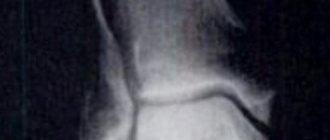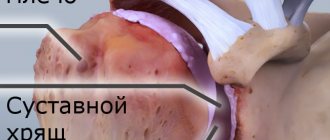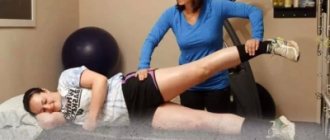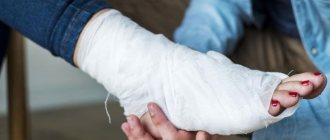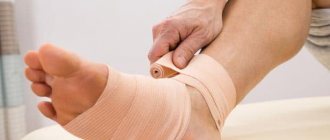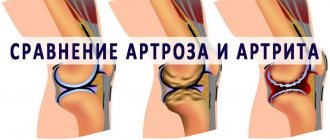Arthrosis of the joints is a common disease in the musculoskeletal system in our country and abroad. This is a degenerative-dystrophic disease of the joints, which, as a rule, is chronic and is subject to exclusively complex treatment. Classic treatment of foot joints helps slow down the development of arthrosis, but does not guarantee complete recovery and restoration of the joint. That is why the ArthroMedCenter joint and spine clinic offers its patients a modern effective technique - MBST therapy, which allows you to restore the affected joint tissues, as well as completely rid a person of the disease without pain and operations!
What is arthrosis of the foot?
Osteoarthritis of the foot that occurs at an early stage is almost impossible to detect. At first it is asymptomatic. Therefore, if you experience any symptom of pain in the feet, you must immediately contact a specialist who will carry out the necessary diagnostics. The presence of the following symptoms may indicate progressive arthrosis:
1. A dull pain, usually occurring in the area of the damaged joint. It clearly manifests itself during any physical activity, including walking, running or standing for long periods of time.
2. Regularly occurring crunching in the joints. Quite often it occurs when moving the feet, toes, running or performing strength exercises.
3. Frequent swelling in the feet, which appears after physical activity. Quite rare, but there are cases of foot arthrosis, when swelling occurs for no reason. As a rule, some kind of physical activity is necessary for the manifestation of edema in this disease.
4. Numbness in the muscles. Quite often it appears in the morning upon waking up.
5. When the feet are deformed due to a degenerative disease, resting on the leg becomes extremely uncomfortable. This subsequently manifests itself in the form of clubfoot and lameness. There is a change in gait that is obvious to others.
6. A person with arthrosis of the foot experiences disturbances in their general psychological state over time. This is due to regular pain in the feet, which causes insomnia, loss of appetite (up to its complete loss), fatigue and nervousness.
It is worth noting that it is women whose age has reached thirty years who are most often susceptible to arthrosis of the foot. According to statistical medical studies, about eighty percent of females have already experienced arthrosis or are predisposed to its occurrence.
The trouble with degenerative-dystrophic foot disease is the permanent pain and complete deformation of the feet, which in some cases does not even make it possible to purchase comfortable shoes. In rare cases, the patient is unable to move without assistance.
Complications in the absence of treatment for arthrosis of the feet
If treatment for arthrosis of the foot is ignored, as well as without timely intervention in the progressive process of damage to the joints of the foot, the disease develops quite quickly. Ultimately, this provokes the complete destruction of cartilage tissue and the occurrence of inflammatory processes in the muscle corset. These internal processes are expressed not only by severe pain in the feet, but also by complete deformation, as well as the proliferation of bone tissue in the joint. Thus, the foot loses the ability to move and a person with foot arthrosis cannot move independently. There is a worsening of the psychological state caused by the patient’s discomfort from his inferiority.
Diagnostics
If signs of arthrosis of the metatarsophalangeal joints occur, patients should consult an orthopedist. The doctor will conduct a survey, during which he will find out the nature of the patient’s complaints and lifestyle, and then proceed to the examination. At the same time, he always pays attention not only to the condition of the joints themselves, especially the big toe, but also to the condition of the skin. Already on the basis of these data, an orthopedist can diagnose the presence of arthrosis of the metatarsophalangeal joints.
But to accurately determine the degree of degenerative-dystrophic changes, the presence of an inflammatory process and other changes, the following must be prescribed:
- UAC and OAM;
- x-ray of feet in two projections;
- Ultrasound of the metatarsophalangeal joints;
- CT and MRI (prescribed in complex cases when other methods cannot determine the specific course of pathological changes).
Factors for the occurrence of arthrosis of the feet
To date, several factors have been identified that can lead to arthrosis of the feet. With prolonged and constant exposure to one of the factors listed below, there is a high probability that a degenerative disease will begin to actively progress:
1. For congenital pathologies and foot diseases. For example, with chronic flat feet, club feet and deviations from the anatomical norm. In this regard, it is recommended to regularly diagnose arthrosis by a specialist.
2. The presence of any injuries, especially with dangerous fractures leading to deformation of the bone skeleton of the feet. This can lead to changes in gait, as well as the general psychological state of a person. In medical practice, there have been cases where even a small bruise led to the development of degenerative-dystrophic foot disease. Refusal of timely treatment allowed the disease to progress.
3. Arthrosis is quite often an occupational disease in such professional fields as service, trade, production, and the like. This is due to the fact that workers have to be on their feet most of the time they work.
4. Severe obesity and even a few extra pounds can put serious stress on the feet. In a woman, arthrosis of the feet may begin to progress during a multiple pregnancy.
5. Incorrectly chosen shoes. Arthrosis occurs when wearing shoes that are inappropriate for the season, and this also leads to frostbite.
6. Presence of diabetes mellitus, as well as diseases related to endocrinology. They can lead to poor blood supply and clogged blood vessels.
7. Dependence on nicotine, alcohol, lack of physical activity, abuse of fatty foods - sooner or later this will lead to a deterioration in the general condition of a person and the possible appearance of disorders in the joints.
8. Uncomfortable shoes. As a rule, female representatives' excessive love for high heels inevitably leads to disorders in the musculoskeletal system and arthrosis.
The presence of simultaneous exposure to several factors increases the risk of developing such a disease. Degenerative-dystrophic disorders in the foot occur locally, at the site of exposure to the source of discomfort. For example, long walks on a high platform or uncomfortable last will cause pain on the toes. Regular discomfort will cause foot deformation. Moreover, pain will appear on both feet. While pain resulting from a fracture or bruise will appear only on one foot.
Main causes and principles of progression of ankle osteoarthritis
Arthrosis of the ankle joint is a special disease that can be a primary phenomenon, or it can be secondary, in which the disease progresses after injury or inflammation.
Regardless of the type, arthrosis occurs mainly in conditions of disruption of the natural processes occurring inside the articular cartilage.
Considering the key factors in the development of the disease, it is worth highlighting:
- microtraumas, as well as major injuries to the ankle joint;
- excess body weight;
- performing surgery on a joint;
- improperly selected shoes, abuse of high heels;
- excessive physical activity;
- metabolic disorders caused by various diseases (gout, hormonal imbalance);
- diseases of the musculoskeletal system;
- genetic predisposition;
- bad ecology.
Under conditions of normal metabolic processes, the superficial articular tissues are characterized by smoothness and elasticity, ensuring unhindered gliding during movement.
When a joint is injured or metabolic processes are disrupted, the smoothness and elasticity of the tissues is lost, which causes friction and significantly aggravates the consequences.
Arthrosis of the foot: symptoms and treatment
As mentioned earlier, classical treatment of foot joints is a complex process. It is divided into medicinal treatment and preventive treatment. The medicinal method consists of the following procedures:
1. Treatment of arthrosis of the feet with the use of non-steroidal painkillers. The new generation of drugs makes it possible to achieve not only the prevention of the development of inflammatory processes, but also relieve the patient from uncomfortable pain. These medications show high effectiveness after using them in a course. The dose and duration of administration are determined by the attending physician.
2. If the person has severe pain, they are given a corticosteroid injection. Due to the fact that the medicine contains quite strong substances, the use of this injection is permissible only once every seven days.
3. The most common drug for the treatment of foot joints is a chondroprotector. Its action is aimed at restoring damaged cartilage and protecting it from subsequent deformation.
4. A medicine based on hyaluronic acid is often used to treat degenerative foot disease. Injection injections allow you to increase the motor capabilities of the leg joints and reduce pressure on them.
5. As a preventive treatment for arthrosis of the feet, a special ointment and cream can be prescribed, which have a beneficial effect on the feet.
Preventive treatment of foot arthrosis is also widely used. It is worth noting that all of the following methods can be used both as a prophylactic to prevent the occurrence of this disease, and in combination with drug treatment of already progressing arthrosis of the foot:
1. Application of the so-called plaster “boot”. It is prescribed to a patient in the presence of a severe stage of development of the disease, when it is necessary to eliminate it as soon as possible.
2. Using an orthopedic insole or arch support. They are aimed at increasing blood flow in the joints of the legs. In turn, they promote tissue metabolism.
3. Regular foot massage. Its use is permissible at almost all stages of arthrosis. However, it is recommended to refrain from this procedure during periods of acute pain.
4. To increase the effectiveness of drug treatment, the patient may be prescribed laser and magnetic therapy.
5. The use of therapeutic mud allows the leg joints to receive the necessary beneficial vitamins for their normal functioning, as well as relieve excessive stress during physical activity.
6. Surgical intervention is a procedure that is prescribed to a patient who is in the last stage of arthrosis of the foot. If there is no desired result from the use of alternative methods and medicines, the patient will require surgery.
Diet
Diet is one of the most important factors in the treatment of arthrosis. If you are overweight, you need to reduce it to reduce the stress on your joints. In this case, a balanced diet with a calorie deficit is prescribed. Regardless of body mass index, doctors recommend completely avoiding:
- fast carbohydrates (sugar, desserts, flour);
- alcoholic drinks;
- spices;
- legumes;
- strong tea and coffee;
- excessively fatty and spicy foods.
Canned food and offal are not excluded, but are significantly limited, as is salt. An ideal diet for osteoarthritis includes:
- lean meats;
- fish and seafood;
- eggs;
- dairy products;
- flaxseed and olive vegetable oils;
- vegetables and fruits, a large amount of greens;
- cereals in moderation, durum wheat pasta;
- products with a high content of collagen (jellied meat, jellied meat, jelly).
Treatment of foot joints using MBST therapy
An effective innovative technique of MBST therapy will help you completely get rid of arthrosis of the foot. This type of treatment starts the metabolic process, the cells begin to recover quickly. The exact cause of the disease is eliminated, while the patient feels a significant improvement in well-being, and the unpleasant symptoms of pain and inflammation go away.
The affected area of the foot is influenced by a special magnetic resonance field. It sends signals that trigger the regeneration process. In this case, the progression of the disease stops, and the active recovery process begins. At the moment, MBST therapy is the most effective and fastest treatment method. After 10 sessions the patient feels improvements. Treatment of arthrosis of the feet using the MBST method allows you to maintain the positive effect for more than 5 years after completing the course.
Moscow, metro station Dubrovka, st. Sharikopodshipnikovskaya, 6/14
| Loading map... |
